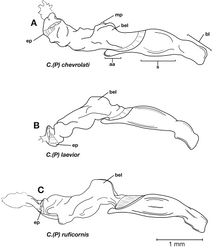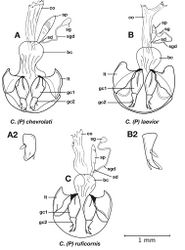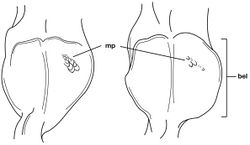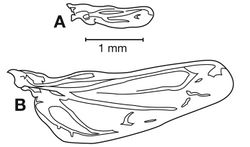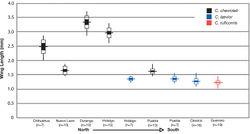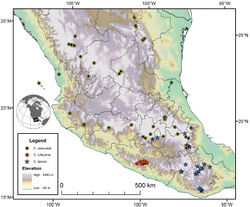Cymindis chevrolati
Contents
- 1 Taxonavigation
- 2 Name
- 3 Type locality
- 4 Specific epithet
- 5 Notes about types, homonymy, and synonymy
- 6 Diagnosis
- 7 Description
- 8 Collection notes and habitat
- 9 Geographical distribution
- 10 Morphological affinities
- 11 Chorological affinities
- 12 Material examined
- 13 Taxon Treatment
- 14 Other References
- 15 Images
| Notice: | This page is derived from the original publication listed below, whose author(s) should always be credited. Further contributors may edit and improve the content of this page and, consequently, need to be credited as well (see page history). Any assessment of factual correctness requires a careful review of the original article as well as of subsequent contributions.
If you are uncertain whether your planned contribution is correct or not, we suggest that you use the associated discussion page instead of editing the page directly. This page should be cited as follows (rationale):
Citation formats to copy and paste
BibTeX: @article{Hunting2013ZooKeys259, RIS/ Endnote: TY - JOUR Wikipedia/ Citizendium: <ref name="Hunting2013ZooKeys259">{{Citation See also the citation download page at the journal. |
Ordo: Coleoptera
Familia: Carabidae
Genus: Cymindis
Name
Cymindis chevrolati Dejean – Wikispecies link – Pensoft Profile
- Cymindis atrata Chevrolat 1835[1], fasc. 7, No. 152 (not Dejean 1831[2]: 327).— TYPE MATERIAL in OXUM: four specimens (2 males, 2 females) three of which are in front of the following green box label: “Cymindis/ Chevrolati/ Dj Cat-3, p.9/ atrata Chv Col Mus 1835/ fasc 7- 152/ Mexico/ D. Sallé “ [handwritten]. LECTOTYPE (here designated) male, labeled: [small green square]; “Chevrolat/ Carabidae/ Fr. V. d. Poll/ Pres. 1909, E./ B. Poulton.” PARALECTOTYPES, (three, here designated), two of which in front of above box label: male, [two lines of illegible handwriting]; “Chevrolat/ Carabidae/ Fr. V. d. Poll/ Pres. 1909, E./ B. Poulton”; female, “Cymindis nigrita Ch”/ “Mexico” [? handwritten]; “Chevrolat/ Carabidae/ Fr. V. d. Poll/ Pres. 1909, E./ B. Poulton”. Paralectotype 3, female, in front of green box label: Cymindis/ nigrita Chd Bull. Mosc./ 1837-VII p. 6/ Mexico D. Sallé” [handwritten]. Specimen labeled: “Cymindis/nigrita Chaud./ Mexique”; “Chevrolat/ Carabidae/ Fr. V. d. Poll/ Pres. 1909, E./ B. Poulton”. – Dejean 1836[3]: 9. –Bates 1883[4]: 187, and 1891[5]: 270.
- Cymindis chevrolatii Dejean 1836[3]: 9 [replacement name for Cymindis atrata Chevrolat 1835[1]]. – Chaudoir 1873[6]: 54.
- Cymindis nigrita Chaudoir 1837[7]: 6–8 [unnecessary replacement name for Cymindis atrata Chevrolat 1835[1]]. – Chaudoir 1873[6]: 54, and 1875[8]: 4.
- Cymindis amblygona Bates 1878[9]: 606. TYPE MATERIAL: not seen. TYPE AREA: Mexico.
- Cymindis angulifera Bates 1878[9]: 606. TYPE MATERIAL: not seen. TYPE AREA: Mexico.
- Pinacodera atrata var. amblygona Bates 1883[4]: 187.
- Pinacodera atrata var. angulifera Bates 1883[4]: 187.
- Pinacodera chevrolati Csiki 1932[10]: 1487. – Blackwelder 1944[11]: 62.
Type locality
Cruz Blanca, Veracruz, Mexico.
Specific epithet
The original spelling is “chevrolatii”, but relatively recent catalogues (Csiki 1932[10], Blackwelder 1944[11], Lorenz 2005[12]), have omitted the terminal “i”, thus “chevrolati”. Such a modification produces an incorrect subsequent spelling, but I accept the catalogue entries as “prevailing usage”, and the latter name as a correct original spelling (International Code of Zoological Nomenclature 1999[13]: 43, art. 33.3.1).
Notes about types, homonymy, and synonymy
The description of Cymindis atrata by Chevrolat (1835[1]: fasc. 7, No. 152) was based on a few specimens collected near Cruz Blanca, Veracruz, by “Sallé”.
As implicitly indicated by Dejean (1836[3]: 9), the name Cymindis atrata Chevrolat was a junior homonym of Cymindis atrata Dejean (1831, a species that was subsequently transferred to the genus Inna Putzeys (Chaudoir 1872[14]) and then to Eucheila Dejean (Shpeley and Ball 2001[15]). As a replacement name, Dejean proposed Cymindis chevrolatii, using as a voucher specimen a male received from Louis Reiche, labeled “chevrolatii mihi/ atrata Chevrolat/ Mexico, d. Reiche “ [green paper, handwritten]. This specimen is in the Chaudoir/ Oberthür collection, in front of the box label “nigrita Chaudoir” (MNHP). That specimen might have come originally from the Chevrolat collection to Reiche, and then to Dejean (ultimately to Chaudoir). Chaudoir (1837[7]: 8) recorded that he had received specimens from Chevrolat of Cymindis atrata, which he renamed Cymindis nigrita, evidently being unaware that Dejean had provided a new name in 1836. These four specimens (3 males, 1 female, each labeled “Ex Musaeo/ Chaudoir” [red print] ), are in front of the box label “nigrita / Chaud./ Mexique/ Cruz Blanca/ Sallé” (MNHP). As demonstrated by similarity in the male genitalia, the male lectotype is conspecific with the Dejean voucher for Cymindis chevrolatii, and for Cymindis atrata Chevrolat.
Authentic specimens of Cymindis amblygona Bates and Cymindis angulifera Bates were not located in neither The Natural History Museum (London) nor the Museum National d’Histoire Naturelle (Paris), though they were sought in both of those collections that are known to house the Bates material on which his New World work was based. Bates (1883[4]: 187) noted that the features he had originally used to distinguish these two forms were exceedingly variable, even within single populations, citing as an example the series collected at Tehuacan, Mexico. Regarding Cymindis amblygona, he stated that “even the definition of the form as a variety is impossible”. Possibly, then, he removed the type labels from what were the type specimens of these forms. Bates described two additional varieties of “Cymindis atrata”: Cymindis atrata ruficornis and Cymindis atrata laevior. These are treated below, as separate species.
Diagnosis
Adults of Cymindis chevrolati (Fig. 30) are distinguishable from those of other species of the limbata species group through genitalic characters: in males a distinct microtrichial patch (mp) on the basal endophallic lobe (bel) of the endophallus (Figs 34A, 36). This patch can be seen in many males through the cleared phallus with endophallus inverted, located near the apex of the phallus. From the right lateral aspect, an everted sac has the microtrichial patch located on the dorsal surface of the basal lobe of the endophallus. Female genitalia differ from other species in the short, stout form of gonocoxite 2 (gc2) (Fig. 35, A2).
Description
With character states of subgenus Pinacodera and chevrolati complex restricted as follows: OBL 10.3 – 13.5 mm. Length (n= 10 males, 10 females): head 1.00 – 1.24, pronotum 1.96 – 2.56, elytra 5.41 – 7.08, metepisternum 1.10 – 1.70 mm; width: head 2.04 – 2.60, pronotum 2.48 – 3.28, elytra 3.83 – 5.16, metepisternum 0.66 – 1.02 mm.
Body proportions. HW/HL 1.88 – 2.31; PWM/PL 1.26 – 1.37; EL/EW 1.25- 1.43; ML/MW 1.66 – 2.00.
Color (Fig. 30). Dorsum of head black, rarely rufo-piceous in front of eyes; legs piceous to rufo-piceous.
Microsculpture. Elytra with mesh pattern isodiametric, microlines shallow in basal half of elytra and shallow to absent from apical half.
Macrosculpture and pilosity. Dorsal punctures with setae present though short and almost not visible at 50× magnification. Ventral surface of head with evenly scattered setigerous punctures (bearing somewhat long setae) from behind eye laterally toward mentum. Pronotum normally with relatively evenly scattered setigerous punctures throughout (Fig. 31A), more densely so toward margins; few specimens with setigerous punctures along margin and few to no punctures on disc (Fig. 31B). Elytral epipleuron glabrous.
Fixed setae. Pronotum with two fixed setae along each margin. Four to six setae (typically four) along apical margin of sternum VII (Fig 3).
Luster. Elytra glossy in basal two thirds, in some specimens slightly less so in apical third.
Head (Fig. 37B-D). Mental tooth form varied.
Elytra (Fig. 30). Humeri narrowly rounded.
Hind wings. Somewhat to markedly reduced (Fig. 39). Length 1.34 – 3.29 mm, mean 2.28 mm.
Male genitalia. Phallus (Fig. 34A) length 2.20–2.48 mm. Endophallus with microtrichial patch on basal lobe of everted sac (Fig. 36).
Female genitalia. Gonocoxite 2 (gc2) (Fig. 35A) short and stout.
Collection notes and habitat
The known elevational range of Cymindis chevrolati extends from sea level to 3400 m, though it is important to note that specimens found at or near sea level were collected from the Tres Marias Islands, the immediately adjacent mainland and one other additional record from El Ebano, San Luis Potosi, that may be mislabeled or misinterpreted by me as Ebano, San Luis Potosi. Typically this species is found further inland and at higher elevation, mostly between 2000–3000 m. Specimens were collected under and around woody debris and stones in forests of oak, pine, fir, juniper and alder, in thorn scrub, and in stands of yucca. As well, the species occupies meadow, desert and grassland habitats.
Geographical distribution
(Fig. 41) The range of this species is restricted to Mexico, extending in the Sierra Madre Occidental from Chihuahua south to Jalisco, in the Sierra Madre Oriental from central Nuevo Leon south to Hidalgo, and in the Transvolcanic Sierra of central Mexico as far south as central Puebla.
Morphological affinities
Based on genitalic characteristics and wing length states (Fig. 40), I postulate that Cymindis chevrolati is the closest relative of Cymindis laevior + Cymindis ruficornis.
Chorological affinities
Cymindis chevrolati is sympatric in a portion of its range with Cymindis laevior in the southernmost portion of its range (Fig. 41). It is also sympatric with Cymindis punctigera punctigera in the La Michilia area of southern Durango.
Material examined
I examined 662 specimens: 38 males and 26 females were dissected. For details see University of Alberta Strickland Virtual Entomology Museum Database (University of Alberta 2009[16]).
Taxon Treatment
- Hunting, W; 2013: A taxonomic revision of the Cymindis (Pinacodera) limbata species group (Coleoptera, Carabidae, Lebiini), including description of a new species from Florida, U.S.A. ZooKeys, 259: 1-73. doi
Other References
- ↑ 1.0 1.1 1.2 1.3 Chevrolat L (1835) Coléoptères du Mexique, Strasbourg, fasc. 5, [50 pp.]; fasc. 7, [50 pp.]; fasc. 8, [68 pp.].
- ↑ Dejean P (1831) Spécies general des coléoptères de la collection de M. le comte Dejean, vol. 5, Paris, 883.
- ↑ 3.0 3.1 3.2 Dejean P (1836) Catalogue des coléoptères de la collection de M. le comte Dejean. Troisième edition, revue, corrigée et augmentée, livr. 1–4, Paris, 1–468.
- ↑ 4.0 4.1 4.2 4.3 Bates H (1883) Biologia Centrali-Americana, Insecta, Coleoptera, Carabidae, Cicindelidae supplementa vol. 1, pt. 1, 153–256, pls. vi-xii.
- ↑ Bates H (1891) Additions to the carabideous fauna of Mexico, with remarks on some of the species already recorded. Transactions of the Entomological Society of London 1891, 223–278, illus.
- ↑ 6.0 6.1 Chaudoir M (1873) Essai monographique sur le genre Cymindis proprement dit. Berliner Entomologische Zeitschrift 17: 53-120.
- ↑ 7.0 7.1 Chaudoir M (1837) Genres nouveaux et espèces nouvelles de coléoptères de la famille des carabiques. Bulletin de la Société Impériale des Naturalistes de Moscou vol. 10, No. 7, 3–48.
- ↑ Chaudoir M (1875) Genres aberrants du groupe des cymindides. Bulletin de la Société Impériale des Naturalistes de Moscou vol. 49, pt. 2, pp. 1–61
- ↑ 9.0 9.1 Bates H (1878) On new genera and species of geodephagous Coleoptera from Central America. Proceedings of the Zoological Society of London, 587–609.
- ↑ 10.0 10.1 Csiki E (1932) Coleopterorum catalogus, pars 124, Carabidae: Harpalinae VII, 1279–1598. (Vol. III.)
- ↑ 11.0 11.1 Blackwelder R (1944) Checklist of the coleopterous insects of Mexico, Central America, the West Indies, and South America. Part 1. Bulletin of the United States National Museum No. 185, 1–188.
- ↑ Lorenz W (2005) Systematic List of Extant Ground Beetles of the World. (Insecta, Coleoptera, Adephaga: Trachypachidae & Carabidae incl. Paussinae, Cicindelinae, Rhysodinae). Second edition. Germany: 1–530.
- ↑ International Code of Zoological Nomenclature (1999). Fourth Edition. XXIX + 306 pp.
- ↑ Chaudoir M (1872) Descriptions d’especes nouvelles de carabiques de la tribu des Troncatipennes, et remarques synonymiques. Revue et Magazin de Zoologie (2) 23: 219–221, 241–244.
- ↑ Shpeley D, Ball G (2001) A taxonomic review of the subtribe Pericalina (Coleoptera: Carabidae: Lebiini) in the Western Hemisphere, with descriptions of new species and notes about classification and zoogeography. Insecta Mundi 14(1–3)): 1-185.
- ↑ University of Alberta (2009) E. H. Strickland Virtual Entomology museum Database. Retrieved August 25, 2009, Web site: http://www.entomology.museums.ualberta.ca/
Images
|



